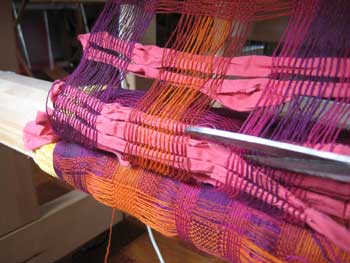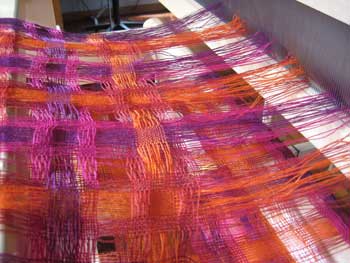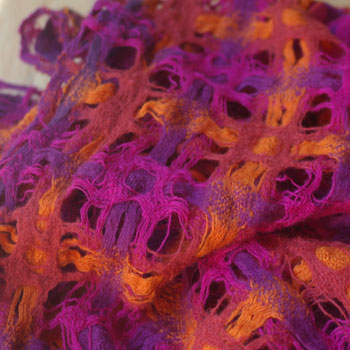 When I complete any woven textile I have mixed feelings. One is of excitement at the prospect of seeing the culmination of my work after the finishing process and the other a sense of loss; to the nice weaving rhythm which takes me a warp to build up.
When I complete any woven textile I have mixed feelings. One is of excitement at the prospect of seeing the culmination of my work after the finishing process and the other a sense of loss; to the nice weaving rhythm which takes me a warp to build up.
Of course, this sense of loss is only present when it’s been a weave structure which allowed a rhythm to get going. If it hasn’t… a big sense of relief is my overwhelming feeling.

This project was really fun to weave and when the finishing involves fulling wool I get so motivated that I forget about cooking dinner and go straight to boiling the water for the textile. You know how it goes – any left overs in the fridge are perfect for these nights.
The photo here of the cutting apart of the scarves looks very precarious. And it is. One slip up and the scarf is in trouble. It’s part of the extreme textile work weavers get into.  The fabric as it came off the loom was flimsy yet held together better than it looked. I was really careful and sewed the selvedge edges together with quilting cotton to prevent uneven shrinkages at the edges.
The fabric as it came off the loom was flimsy yet held together better than it looked. I was really careful and sewed the selvedge edges together with quilting cotton to prevent uneven shrinkages at the edges.
I also learnt an interesting thing in this project. After weaving for 30 years with Glimakra boat shuttles, I’ve always had problems with my shuttle shooting between threads (that is the wrong ones) or diving down to the floor under the loom.

But a friend gave me an old Leclerc shuttle which was alot heavier than my Glimakra ones – 170g. This shuttle worked like a dream.
No more diving into gaps in the weaving or picking up incorrect threads in the shed. But why?? This weave would test the most reluctant shuttle divers as it actually had 1″ gaps in the weave! I think that the heavier shuttle is more assertive and makes its way across the shed as it should. This older Leclerc shuttle isn’t the same as the newer ones as I also just purchased one from Petlins. The whole shuttle thing really interests me as they are beautiful functional objects. But I’m now looking as weight in a shuttle for some types of weaves.

Leave a Reply